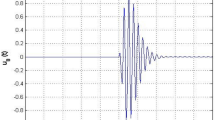Abstract
Constrained by practical and economical aspects, in many applications, one often deals with data sampled irregularly and incompletely. The use of irregularly sampled data may result in some artifacts and poor spatial resolution. Therefore, the preprocessing of the measurements onto a regular grid plays an important step. One of the methods achieving this objective is based on the Fourier reconstruction, which involves an underdetermined system of equations. The recent Uniform Uncertainty Principle (UUP) uses convex optimization through l 1 minimization for solving underdetermined systems. The l 1 minimization admits certain theoretical guarantees and simpler implementation. The present work applies UUP to the Fourier-based data regularization problem. For the signals having sparse Fourier spectra, our method replaces the incomplete and irregular coordinate grid with the grid that is a subset of equispaced complete grid. It then generates error resulting from the stated replacement. Finally, it applies UUP to realize its objective. To justify the applicability of our method, we present the empirical performance of it on different sets of measurement coordinates as a function of number of nonzero Fourier coefficients.
Similar content being viewed by others
References
Aharon M., Elad M.: Sparse and redundant modeling of image content using an image content dictionary. SIAM J. Imaging Sci. 1(3), 228–247 (2008)
Bass R.F., Grochenig K.: Random sampling of multivariate trigonometric polynomials. SIAM J. Math. Anal. 36(3), 773–795 (2004)
Borwein, P., Erdelyi, T.: Polynomals and Polynomial Inequalities. Graduate Texts in Mathematics, vol. 161. Springer (1995)
Bruckstein A.M., Donoho D.L., Elad M.: From sparse solutions of systems of equations to sparse modeling of signals and images. SIAM Rev. 51(1), 34–81 (2009)
Candes E.: The restricted isometry property and its implications for compressed sensing. C. R. Math. Acad. Sci. Paris 346(9–10), 589–592 (2008)
Candes, E.J., Romberg, J.: Practical signal recovery from random projections. In: Wavelet Applications in Signal and Image Processing XI, Proc. of SPIE Conf., vol. 5914 (2004)
Candes E.J., Tao T.: Near-optimal signal recovery from random projections: universal encoding strategies. IEEE Trans. Inform. Theory 52, 5406–5425 (2006)
Candes E.J., Romberg J., Tao T.: Robust uncertainty principles: exact signal reconstruction from highly incomplete frequency information. IEEE Trans. Inform. Theory 52(2), 489–509 (2006)
Candes E.J., Romberg J., Tao T.: Stable signal recovery from incomplete and inaccurate measurements. Commun. Pure Appl. Math. 59, 1207–1223 (2006)
Chen S.S., Donoho D.L., Saunders M.A.: Atomic decomposition by basis pursuit. SIAM Rev. 43(1), 129–159 (2001)
Daubechies I., Defrise M., De Mol C.: An iterative thresholding algorithm for linear inverse problem with a sparsity constraint. Commun. Pure Appl. Math. 57(11), 1413–1541 (2004)
Donoho D.L., Elad M.: On the stability of the basis pursuit in the presence of noise. Signal Process. 86(3), 511–532 (2006)
Donoho D.L., Elad M., Temlyakov V.N.: Stable recovery of sparse overcomplete representations in the presence of noise. IEEE Trans. Inform. Theory 52(1), 6–18 (2006)
Elad M., Starck J., Querre P., Donoho D.: Simultaneous cartoon and texture image inpainting using morphological component analysis (MCA). Appl. Comput. Harmon. Anal. 19, 340–358 (2005)
Fuchs J.J.: On sparse representation in arbitrary redundant bases. IEEE Trans. Inform. Theory 50(6), 1341–1344 (2004)
Hennenfent G., Herrmann F.J.: Seismic denoising with non-uniformly sampled curvelets. Comput. Sci. Eng 8(3), 50–59 (2006)
Polo, Y.L., Wang, Y., Pandharipande, A., Leus, G.: Compressive wide-band spectrum sensing. In: IEEE-ICASSP, pp. 2337–2340 (2009)
Rauhut H.: Random sampling of sparse trigonometric polynomials. Appl. Comput. Harmon. Anal. 22(1), 16–42 (2007)
Rubinstein R., Zibulovsky M., Elad M.: Double sparsity: Learning sparse dictionary for sparse signal approximations. IEEE. Trans. Signal. Process 58(3), 1553–1554 (2010)
Tropp J.A.: Just relax: convex programming methods for identifying sparse signals in noise. IEEE Trans. Inform. Theory 51(3), 1030–1051 (2006)
Zwartjes P.M., Sacchi M.D.: Fourier reconstruction of nonuniformly sampled, aliased seismic data. Geophysics 72(1), V21–V32 (2007)
Author information
Authors and Affiliations
Corresponding author
Rights and permissions
About this article
Cite this article
Sastry, C.S. Spectral Dynamics and Regularization of Incompletely and Irregularly Measured Data. Differ Equ Dyn Syst 19, 181–197 (2011). https://doi.org/10.1007/s12591-011-0081-7
Published:
Issue Date:
DOI: https://doi.org/10.1007/s12591-011-0081-7



